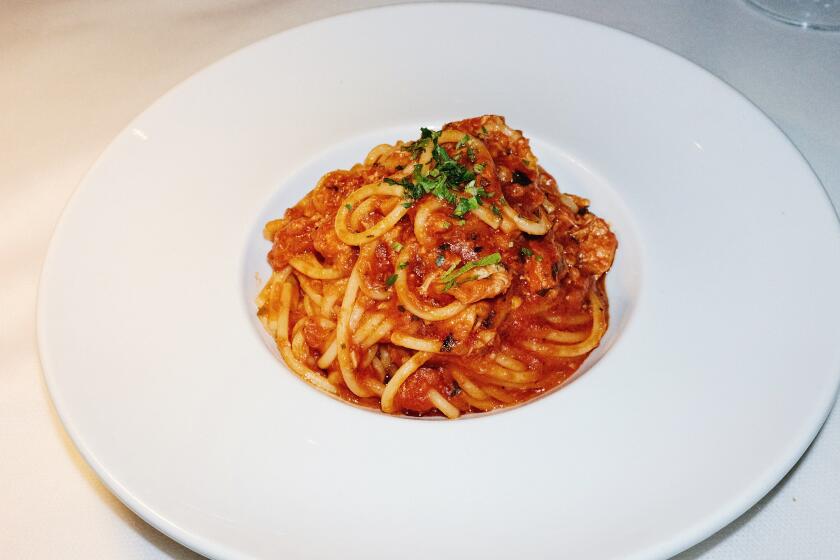Homemade Soba Noodles

- Share via
This recipe is a nihachi-style soba and uses a classic 80%-to-20% ratio of buckwheat to all-purpose flour. For a gluten-free option, replace the all-purpose flour with tapioca flour. You can find some great wheat producers — I particularly like Anson & Mills’ Ni-Hachi Sobakoh.
Special tools come in handy if you want to make artisan-style noodles: a soba bocho (soba knife) for cutting the noodles, a memboh (rolling pin) and a koma-ita (cutting guide). You can find these at Japanese markets or online shops but don’t sweat it if you don’t have them. A kitchen knife and ruler do the job. The thickness will be different from authentic soba noodles but the flavor will be there.
You can also use a pasta machine, but I do encourage you to try making the dough by hand. I recommend using a digital scale to measure the flour. You can find all soba tools at Hitachiyausa.com.
Dampen a paper towel or dish cloth and place underneath the large bowl to stop it from moving. Sift the buckwheat and all-purpose flours into the bowl. Set aside 2 tablespoons of the filtered water and pour the rest in the bowl. Using your fingertips, work the water into the flour until well combined. Scrape any excess dough off your fingers, then continue to work the dough until it forms a crumbly mass.
Using the palms of your hands, knead the dough in a counterclockwise direction, then back to clockwise repeatedly: If the dough feels dry, add a tablespoon of water and continue kneading until the crumbly mass forms dough balls the size of a pebble. Gather the small balls until they form balls the size of walnuts. Eventually, the large balls will combine to form one piece of dough. It should be smooth with no visible cracks. To test the firmness, it should feel like your earlobe.
Press the ball into a disk about 1 inch (2.5 cm) thick. This will take about 5 minutes. If the dough still feels dry, sprinkle a few drops of water, but don’t be tempted to add any more. You don’t want a wet and sticky dough.
Sprinkle the cutting board and the dough with a pinch of tapioca starch. Using a rolling pin, roll the disk into a square of about 18 inches (45 cm) on all sides and 1/8-inch (3 mm) thick. Run the palm of your hand over the surface of the dough and check if there are any thick areas. Do not flip the dough while you are rolling it out. You want it to have an even thickness.
Generously sprinkle starch on the left half of the dough. Fold the right side over the left, but do not press on the fold — it is important not to crease the dough, as this will cause it to crack. The starch keeps the dough from sticking to itself. Next, generously dust the top half of the dough and fold the bottom half over the top half. You will be shaking off the starch after the noodles are cut, so don’t worry about over dusting.
You now have a “stack” of dough that is four layers thick. Starting on your right side (the side where the dough has been folded), use a ruler and knife (or cutting guide and soba knife) to slice it into thin noodles that are even in size, about ⅛-inch (3 mm) thick. Handle the noodles gently by lifting them from their middles and shaking off the dusting starch by tapping the noodles at their ends. Transfer the noodles to a parchment-lined baking sheet, laying them flat. Do not bundle or twist the noodles or they will break. When the sheet is full of noodles, cover it with a dry dish towel and plastic wrap and keep refrigerated until you are ready to cook the noodles. They are best eaten on the same day but will keep for up to two days in the refrigerator.
To cook the noodles, bring a large stockpot of unsalted water to a rolling boil over high heat. Gently drop the noodles into the boiling water, making sure the water stays vigorously boiling so the noodles don’t stick together. Soba noodles need a lot of space to swim in and don’t like to be stirred. It is advised to cook only two servings at a time until al dente, about 90 seconds to three minutes (depending how thick they are).
Scoop the noodles with a large sieve in one scoop. Transfer the noodles to a strainer that is set in a bowl of cold water to stop the cooking. Remove any surface starch by giving the noodles a vigorous rinse under cold running water. Drain and then rinse the noodles once more. Drain thoroughly by hitting the side and bottom of the strainer, but don’t toss the noodles. Transfer the cold noodles to plates and serve immediately.
Get our Cooking newsletter.
Your roundup of inspiring recipes and kitchen tricks.
You may occasionally receive promotional content from the Los Angeles Times.















